pH Sensing for Early Detection of Septic Inflammation Based on Intrinsic Titanium β-Alloy Nanotubular Oxides
Abstract
1. Introduction
- A redox equilibrium between two different solid phases;
- A redox equilibrium in one solid phase, which can be affected by the passage of current;
- A single-phase oxygen equilibrium;
- A simple ion exchange in a surface layer containing OH− groups.
2. Materials and Methods
3. Results
3.1. Description of Surface States
3.2. Stability of Prepared Surfaces
3.3. Response to pH Changes
4. Discussion
5. Conclusions
Author Contributions
Funding
Data Availability Statement
Conflicts of Interest
References
- Zhu, Y.; Weng, X.; Zhang, J.; Mao, J. Protective effect of additional cathelicidin antimicrobial peptide PR-39 on prosthetic-joint infections. J. Orthop. Surg. 2023, 31, 10225536231175237. [Google Scholar] [CrossRef] [PubMed]
- Tomšík, E.; Gunár, K.; Krunclová, T.; Ivanko, I.; Trousil, J.; Fojt, J.; Hybášek, V.; Daniel, M.; Sepitka, J.; Judl, T.; et al. Development of Smart Sensing Film with Nonbiofouling Properties for Potentiometric Detection of Local pH Changes Caused by Bacterial and Yeast Infections Around Orthopedic Implants. Adv. Mater. Interfaces 2022, 10, 2201878. [Google Scholar] [CrossRef]
- Ehrlich, G.D.; Stoodley, P.; Kathju, S.; Zhao, Y.; McLeod, B.R.; Balaban, N.; Hu, F.Z.; Sotereanos, N.G.; Costerton, J.W.; Stewart, P.S.; et al. Engineering Approaches for the Detection and Control of Orthopaedic Biofilm Infections. Clin. Orthop. Relat. Res. 2005, 437, 59–66. [Google Scholar] [CrossRef] [PubMed]
- Gray, M.; Meehan, J.; Ward, C.; Langdon, S.P.; Kunkler, I.H.; Murray, A.; Argyle, D. Implantable biosensors and their contribution to the future of precision medicine. Vet. J. 2018, 239, 21–29. [Google Scholar] [CrossRef]
- Judl, T.; Popelka, S.; Tomšík, E.; Hrubý, M.; Daniel, M.; Fojt, J.; Melicherčík, P.; Landor, I.; Jahoda, D. Acidity Is an Excellent Marker of Infection in Hip and Knee Arthroplasty. J. Clin. Med. 2024, 13, 688. [Google Scholar] [CrossRef]
- Veletić, M.; Apu, E.H.; Simić, M.; Bergsland, J.; Balasingham, I.; Contag, C.H.; Ashammakhi, N. Implants with Sensing Capabilities. Chem. Rev. 2022, 122, 16329–16363. [Google Scholar] [CrossRef]
- Liu, Y.; Su, Y.; Cui, Z.; Guo, Y.; Zhang, W.; Wu, J. Clinical and microbiological features of anaerobic implant-related infection in 80 patients after orthopedic surgery. Anaerobe 2021, 71, 102413. [Google Scholar] [CrossRef] [PubMed]
- Arciola, C.R.; Campoccia, D.; Montanaro, L. Implant infections: Adhesion, biofilm formation and immune evasion. Nat. Rev. Microbiol. 2018, 16, 397–409. [Google Scholar] [CrossRef]
- Friedman, D.B.; Stauff, D.L.; Pishchany, G.; Whitwell, C.W.; Torres, V.J.; Skaar, E.P. Staphylococcus aureus Redirects Central Metabolism to Increase Iron Availability. PLoS Pathog. 2006, 2, e8. [Google Scholar] [CrossRef]
- Puah, A.; Nadzirah, S.; Arshad, M.K.M.; Ayub, R.; Ruslinda, A.R.; Hashim, U. pH Measurement Using Titanium Dioxide Nanoparticles Thin Film Based Sensors. Appl. Mech. Mater. 2015, 754–755, 1120–1125. [Google Scholar] [CrossRef]
- Singewald, T.D.; Traxler, I.; Schimo-Aichhorn, G.; Hild, S.; Valtiner, M. Versatile, low-cost, non-toxic potentiometric pH-sensors based on niobium. Sens. Bio-Sensing Res. 2022, 35, 100478. [Google Scholar] [CrossRef]
- Manjakkal, L.; Szwagierczak, D.; Dahiya, R. Metal oxides based electrochemical pH sensors: Current progress and future perspectives. Prog. Mater. Sci. 2020, 109, 100635. [Google Scholar] [CrossRef]
- Korostynska, O.; Arshak, K.; Gill, E.; Arshak, A. Review Paper: Materials and Techniques for In Vivo pH Monitoring. IEEE Sens. J. 2007, 8, 20–28. [Google Scholar] [CrossRef]
- O’hare, D.; Parker, K.H.; Winlove, C.P. Metal–metal oxide pH sensors for physiological application. Med. Eng. Phys. 2006, 28, 982–988. [Google Scholar] [CrossRef]
- Fog, A.; Buck, R.P. Electronic semiconducting oxides as pH sensors. Sens. Actuators 1984, 5, 137–146. [Google Scholar] [CrossRef]
- Kwon, D.-H.; Cho, B.-W.; Kim, C.-S.; Sohn, B.-K. Effects of heat treatment on Ta2O5 sensing membrane for low drift and high sensitivity pH-ISFET. Sens. Actuators B Chem. 1996, 34, 441–445. [Google Scholar] [CrossRef]
- Selva, J.; Bertotti, M. Iridium Oxides Based Potentiometric Sensor for pH Monitoring in Biological Samples. Braz. J. Anal. Chem. 2023, 10, 90–98. [Google Scholar] [CrossRef]
- Schöning, M.; Brinkmann, D.; Rolka, D.; Demuth, C.; Poghossian, A. CIP (cleaning-in-place) suitable “non-glass” pH sensor based on a Ta2O5-gate EIS structure. Sens. Actuators B Chem. 2005, 111–112, 423–429. [Google Scholar] [CrossRef]
- Macháčková, N.; Jírů, J.; Hybášek, V.; Fojt, J. A Ru/RuO2-Doped TiO2 Nanotubes as pH Sensors for Biomedical Applications: The Effect of the Amount and Oxidation of Deposited Ru on the Electrochemical Response. Materials 2021, 14, 7912. [Google Scholar] [CrossRef] [PubMed]
- Yang, C.-M.; Chiang, T.-W.; Yeh, Y.-T.; Das, A.; Lin, Y.-T.; Chen, T.-C. Sensing and pH-imaging properties of niobium oxide prepared by rapid thermal annealing for electrolyte–insulator–semiconductor structure and light-addressable potentiometric sensor. Sens. Actuators B Chem. 2015, 207, 858–864. [Google Scholar] [CrossRef]
- Nico, C.; Monteiro, T.; Graça, M. Niobium oxides and niobates physical properties: Review and prospects. Prog. Mater. Sci. 2016, 80, 1–37. [Google Scholar] [CrossRef]
- Schindelin, J.; Arganda-Carreras, I.; Frise, E.; Kaynig, V.; Longair, M.; Pietzsch, T.; Preibisch, S.; Rueden, C.; Saalfeld, S.; Schmid, B.; et al. Fiji: An open-source platform for biological-image analysis. Nat. Methods 2012, 9, 676–682. [Google Scholar] [CrossRef]
- NIST X-ray Photoelectron Spectroscopy Database, Version 4.0; National Institute of Standards and Technology: Gaithersburg, MD, USA, 2008. Available online: http://srdata.nist.gov/xps2 (accessed on 12 October 2023).
- Gruber, R.; Singewald, T.D.; Bruckner, T.M.; Hader-Kregl, L.; Hafner, M.; Groiss, H.; Duchoslav, J.; Stifter, D. Investigation of Oxide Thickness on Technical Aluminium Alloys—A Comparison of Characterization Methods. Metals 2023, 13, 1322. [Google Scholar] [CrossRef]
- Carlson, T.A.; McGuire, G.E. Study of the x-ray photoelectron spectrum of tungsten—Tungsten oxide as a function of thickness of the surface oxide layer. J. Electron Spectrosc. Relat. Phenom. 1972, 1, 161–168. [Google Scholar] [CrossRef]
- Haynes, W.M. (Ed.) CRC Handbook of Chemistry and Physics, 92nd ed.; Internet Version 2012; Taylor & Francis Group, LLC: London, UK, 2011. [Google Scholar]
- Fojt, J.; Joska, L.; Malek, J.; Sefl, V. Corrosion behavior of Ti–39Nb alloy for dentistry. Mater. Sci. Eng. C 2015, 56, 532–537. [Google Scholar] [CrossRef] [PubMed]
- Atuchin, V.; Kalabin, I.; Kesler, V.; Pervukhina, N. Nb 3d and O 1s core levels and chemical bonding in niobates. J. Electron Spectrosc. Relat. Phenom. 2005, 142, 129–134. [Google Scholar] [CrossRef]
- Biesinger, M.C.; Lau, L.W.M.; Gerson, A.R.; Smart, R.S.C. Resolving surface chemical states in XPS analysis of first row transition metals, oxides and hydroxides: Sc, Ti, V., Cu and Zn. Appl. Surf. Sci. 2010, 257, 887–898. [Google Scholar] [CrossRef]
- Melo, C.; Silva, L.; Cremasco, A.; Caram, R. TiO2 nanostructured layer formation on Ti-35Nb and Ti-35Nb-5Ta samples: Impact of Ta addition on polymorphic transformation and oxide composition. Mater. Lett. 2024, 355, 135450. [Google Scholar] [CrossRef]
- Benea, L.; Ravoiu, A.; Neaga, V.; Axente, E.R. Using Applied Electrochemistry to Obtain Nanoporous TiO2 Films on Ti6Al4V Implant Alloys and Their Preclinical In Vitro Characterization in Biological Solutions. Coatings 2023, 13, 614. [Google Scholar] [CrossRef]
- Alves, A.; Wenger, F.; Ponthiaux, P.; Celis, J.-P.; Pinto, A.; Rocha, L.; Fernandes, J. Corrosion mechanisms in titanium oxide-based films produced by anodic treatment. Electrochim. Acta 2017, 234, 16–27. [Google Scholar] [CrossRef]
- Jírů, J.; Hybášek, V.; Fojt, J. Preparation of pH-sensitive surface based on mixed oxides of titanium and iridium for early detection of inflammation around the implant. Mater. Chem. Phys. 2023, 305, 128026. [Google Scholar] [CrossRef]
- Zahed, A.; Barman, S.C.; Das, P.S.; Sharifuzzaman; Yoon, H.S.; Yoon, S.H.; Park, J.Y. Highly flexible and conductive poly (3, 4-ethylene dioxythiophene)-poly (styrene sulfonate) anchored 3-dimensional porous graphene network-based electrochemical biosensor for glucose and pH detection in human perspiration. Biosens. Bioelectron. 2020, 160, 112220. [Google Scholar] [CrossRef]
- Yoon, J.H.; Kim, S.-M.; Park, H.J.; Kim, Y.K.; Oh, D.X.; Cho, H.-W.; Lee, K.G.; Hwang, S.Y.; Park, J.; Choi, B.G. Highly self-healable and flexible cable-type pH sensors for real-time monitoring of human fluids. Biosens. Bioelectron. 2019, 150, 111946. [Google Scholar] [CrossRef] [PubMed]
- Voltrova, B.; Jarolimova, P.; Hybasek, V.; Blahnova, V.H.; Sepitka, J.; Sovkova, V.; Matějka, R.; Daniel, M.; Fojt, J.; Filova, E. In vitro evaluation of a novel nanostructured Ti-36Nb-6Ta alloy for orthopedic applications. Nanomedicine 2020, 15, 1843–1859. [Google Scholar] [CrossRef] [PubMed]
- Puigdomenech, I. HYDRA (Hydrochemical Equilibrium-Constant Database) and MEDUSA (Make Equilibrium Diagrams Using Sophisticated Algorithms) Programs; Royal Institute of Technology: Stockholm, Sweden, 2006; Available online: http://www.kemi.kth.se/medusa/ (accessed on 6 December 2023).
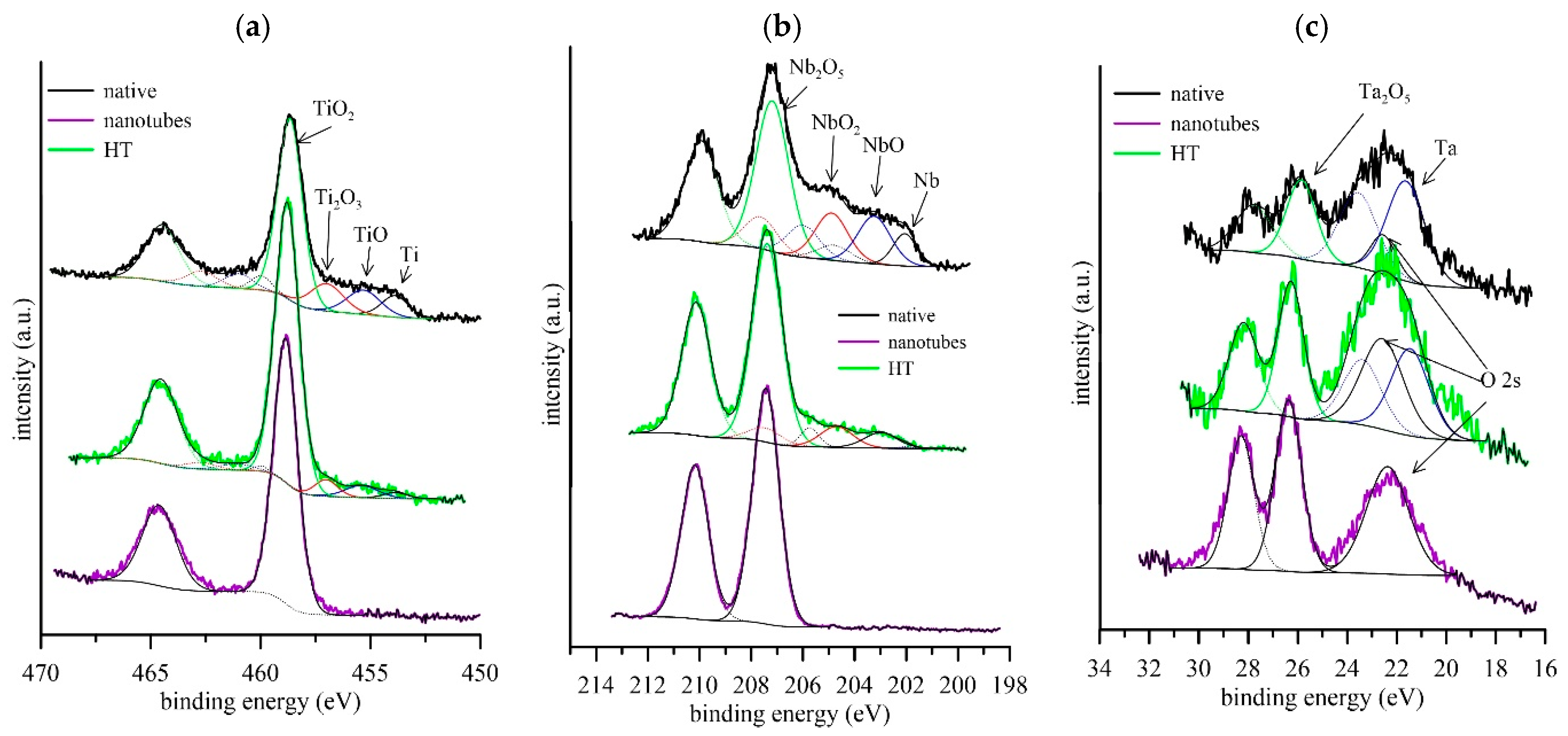
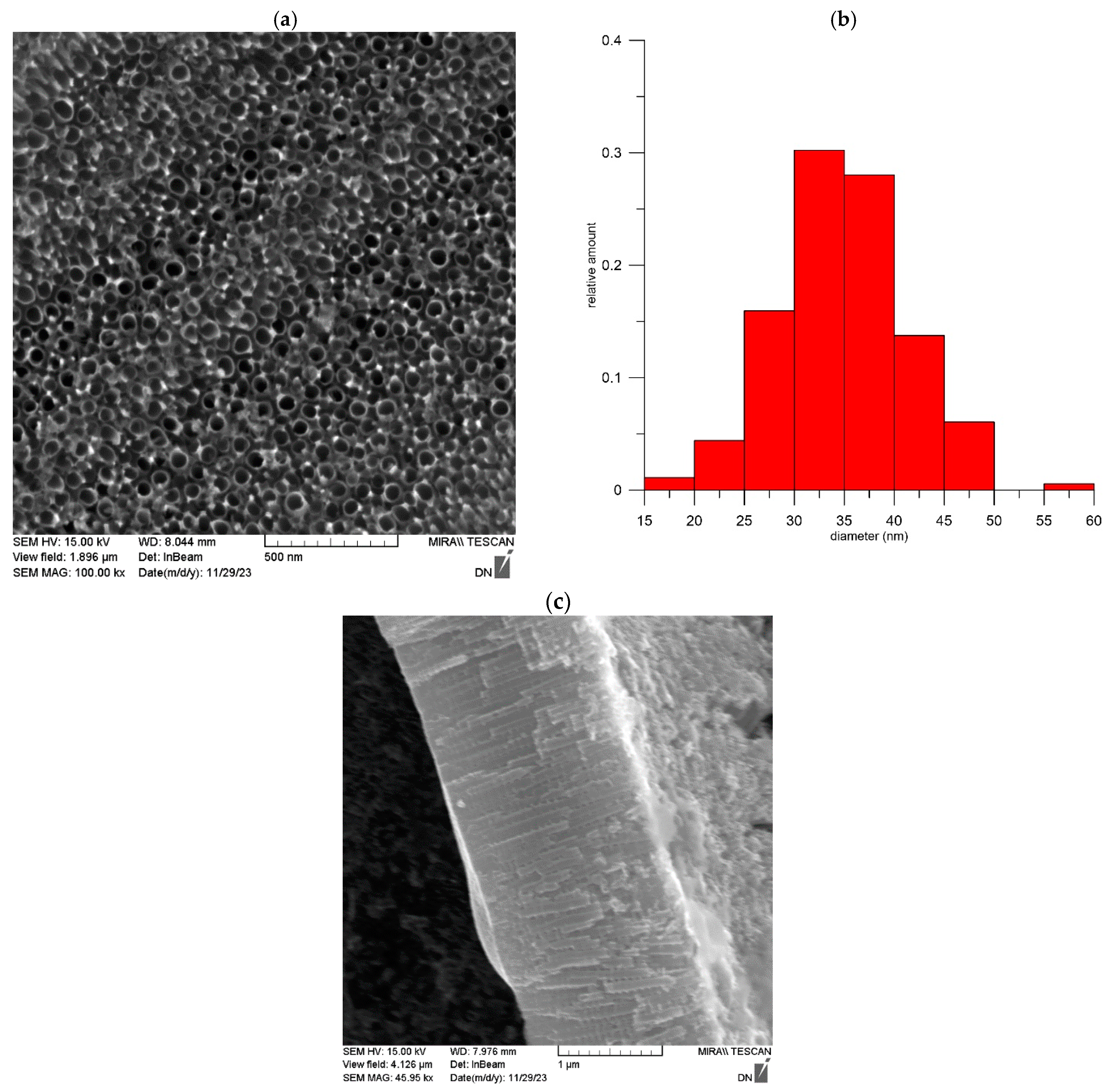
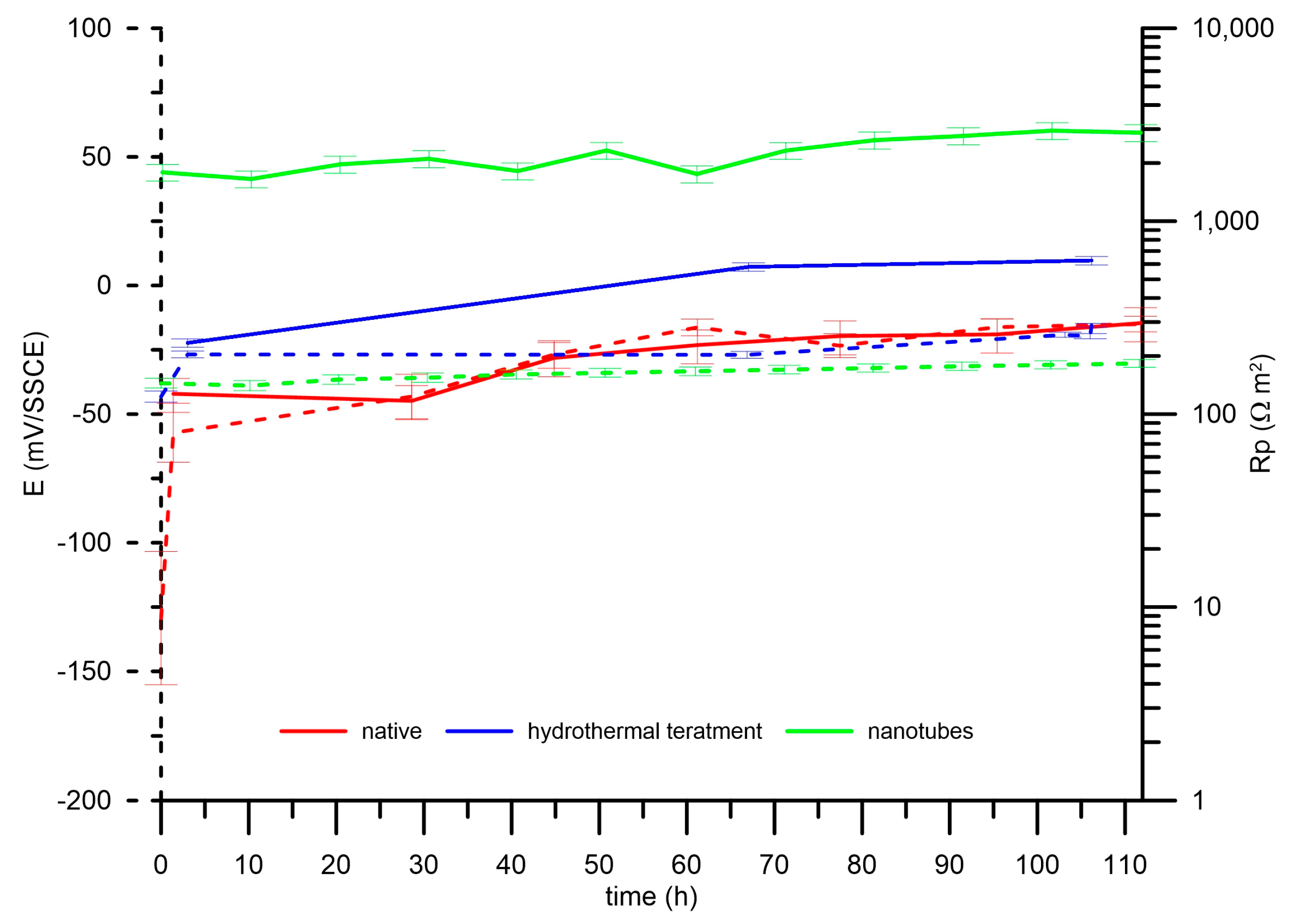
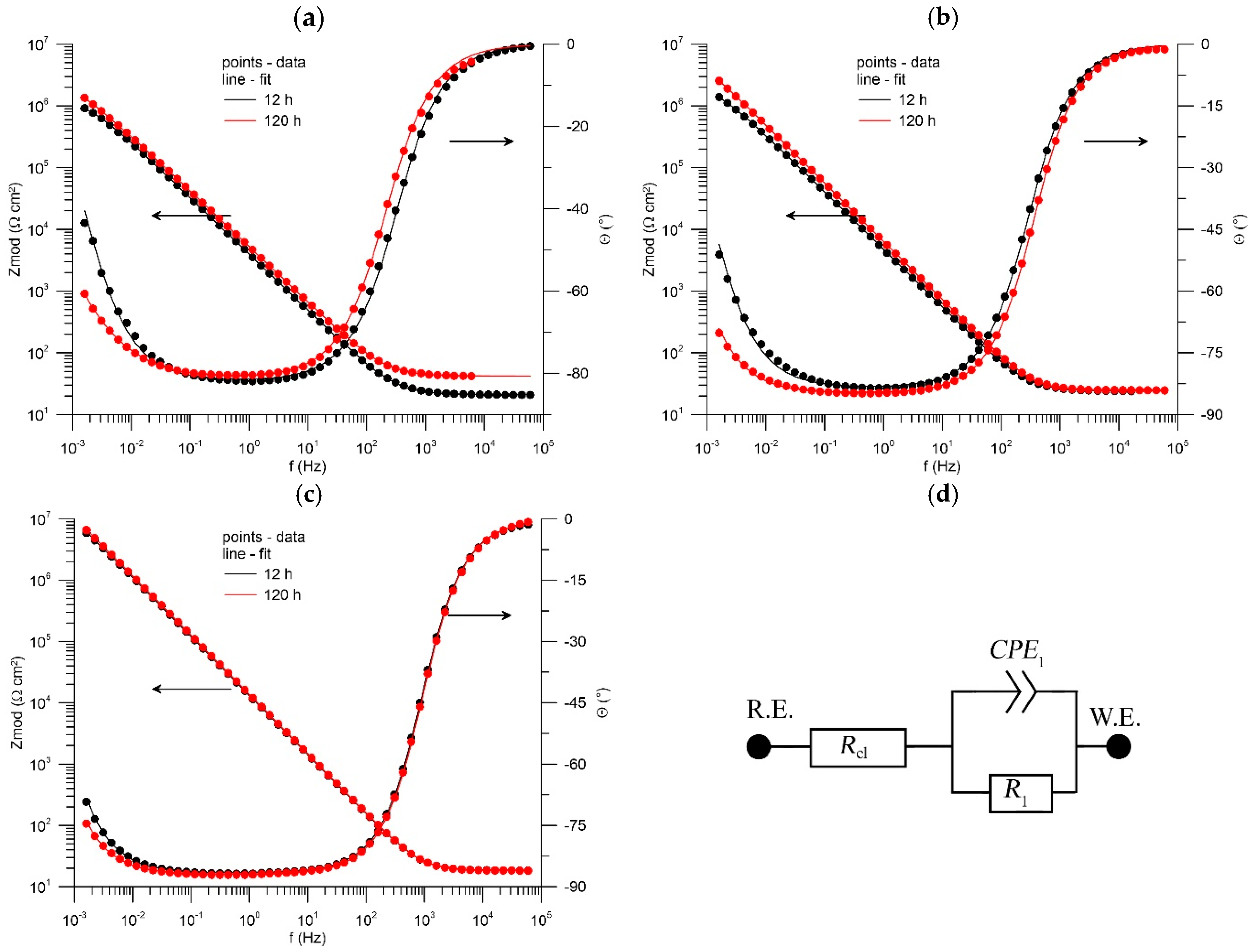
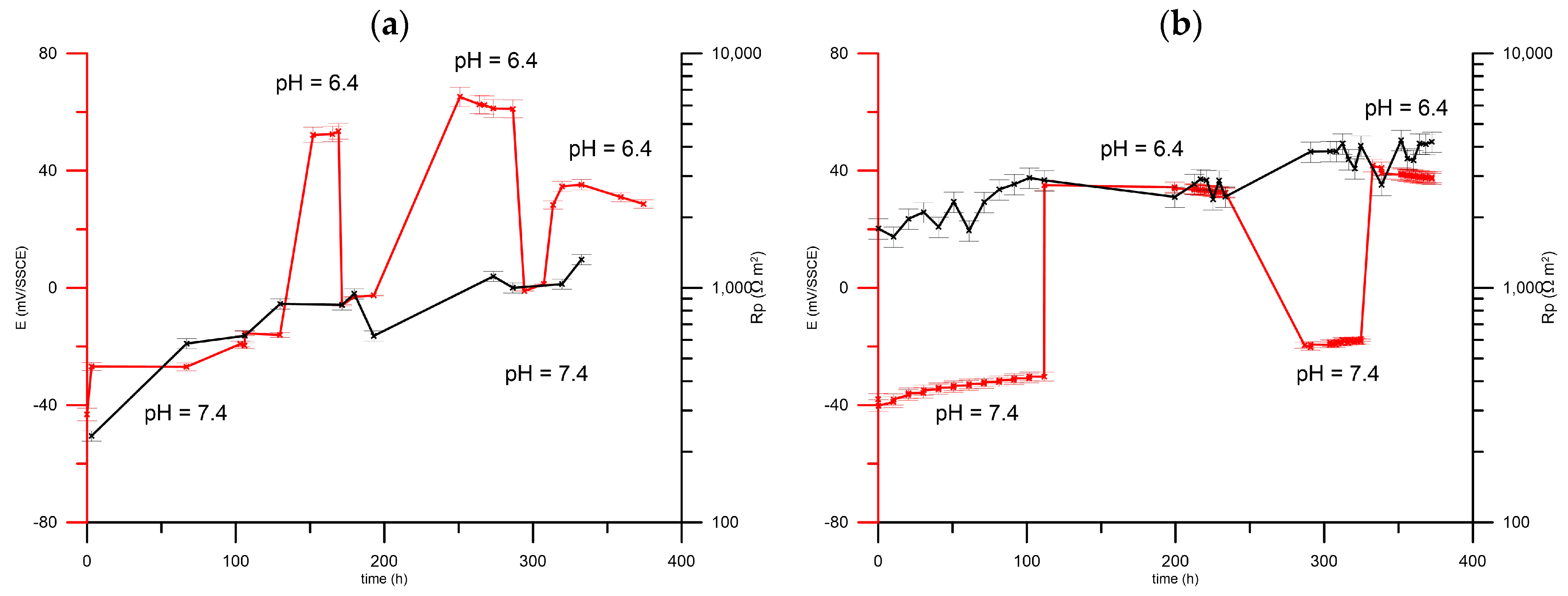
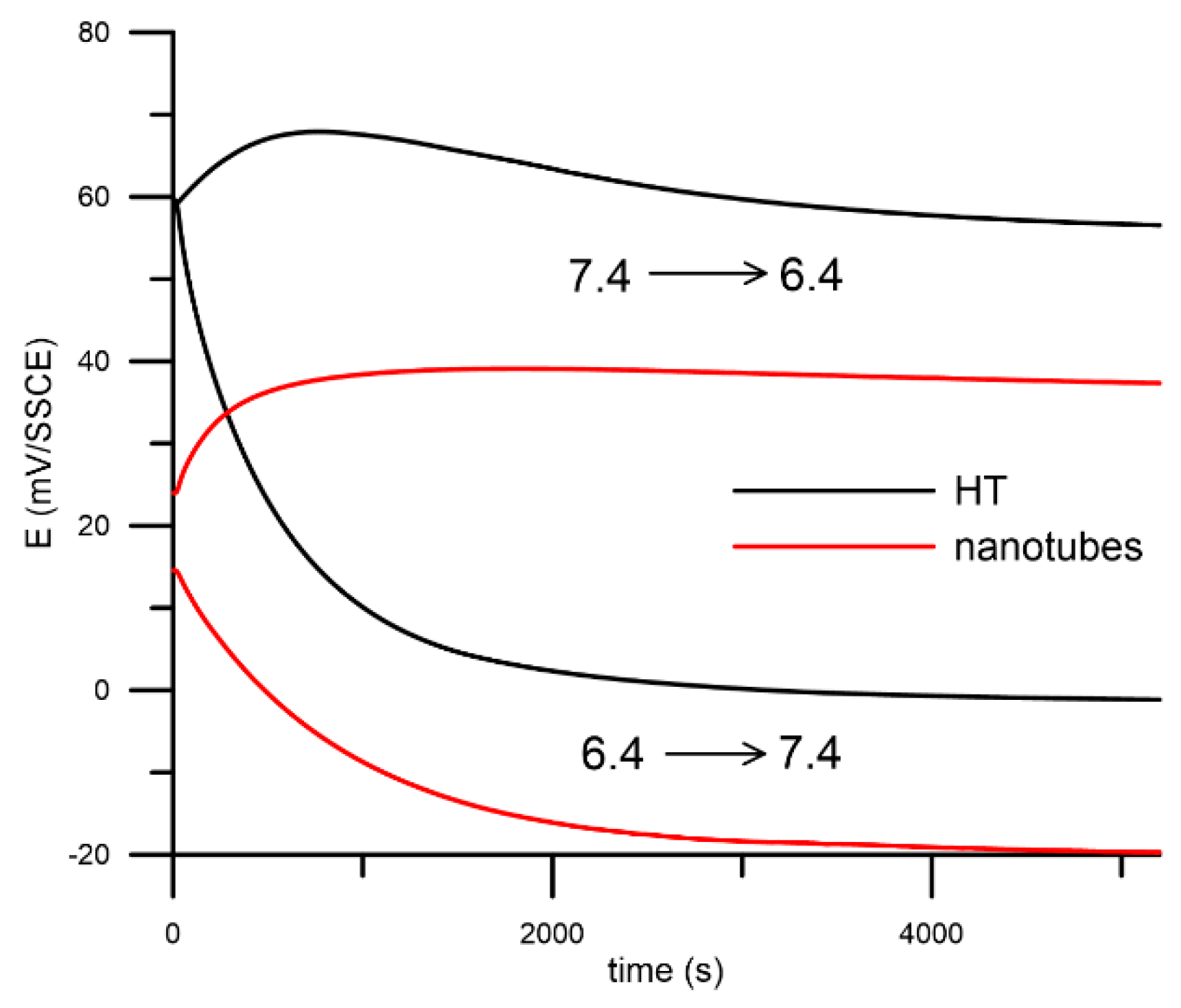
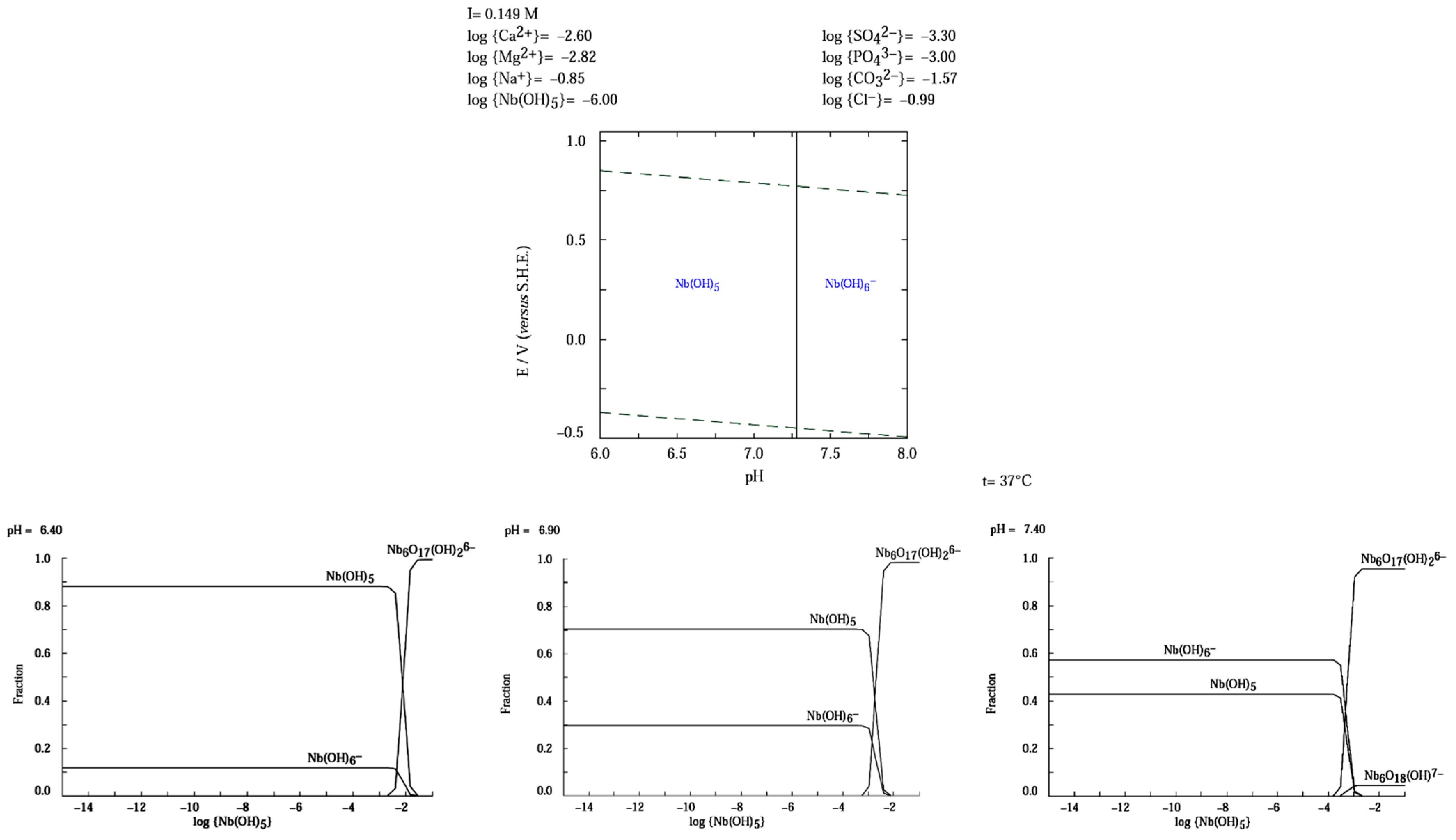
| Ti (%wt.) | Nb (%wt.) | Ta (%wt.) | F (%wt.) | Layer Thickness (nm) | Ti/TiO/Ti2O3/TiO2 Atomic Ratio | Nb/NbO/NbO2/Nb2O5 Atomic Ratio | Ta/Ta2O5 Atomic Ratio | |
|---|---|---|---|---|---|---|---|---|
| nanotubes | 25 | 63 | 12 | >10 | 100% TiO2 | 100% Nb2O5 | 100% Ta2O5 | |
| 25 | 60 | 12 | 3 | |||||
| hydrothermal treatment | 40 | 45 | 15 | 9.7 | 2/5/5/88 | 0/7/10/83 | 50/50 | |
| native layer | 44 | 50 | 6 | 6.5 | 8/12/14/66 | 8/18/18/56 | 62/38 | |
| bulk material | 58 | 36 | 6 |
| Surface | R1 (Ω cm2) | CPE1 (S sα cm−2) | α | Ceff (F cm−2) | χ2 |
|---|---|---|---|---|---|
| native 12 h | 1.36 × 106 | 4.73 × 10−5 | 0.910 | 7.14 × 10−5 | 4.21 × 10−4 |
| native 120 h | 3.53 × 106 | 3.71 × 10−5 | 0.895 | 6.57 × 10−5 | 4.42 × 10−4 |
| HT 12 h | 2.41 × 106 | 3.87 × 10−5 | 0.928 | 5.50 × 10−5 | 2.32 × 10−4 |
| HT 120 h | 9.46 × 106 | 2.78 × 10−5 | 0.942 | 3.92 × 10−5 | 9.64 × 10−5 |
| nanotubes 12 h | 1.92 × 107 | 1.30 × 10−5 | 0.964 | 1.60 × 10−5 | 3.69 × 10−5 |
| nanotubes 120 h | 2.97 × 107 | 1.24 × 10−5 | 0.967 | 1.52 × 10−5 | 3.07 × 10−5 |
Disclaimer/Publisher’s Note: The statements, opinions and data contained in all publications are solely those of the individual author(s) and contributor(s) and not of MDPI and/or the editor(s). MDPI and/or the editor(s) disclaim responsibility for any injury to people or property resulting from any ideas, methods, instructions or products referred to in the content. |
© 2024 by the authors. Licensee MDPI, Basel, Switzerland. This article is an open access article distributed under the terms and conditions of the Creative Commons Attribution (CC BY) license (https://creativecommons.org/licenses/by/4.0/).
Share and Cite
Fojt, J.; Šťovíček, J.; Jírů, J.; Hybášek, V. pH Sensing for Early Detection of Septic Inflammation Based on Intrinsic Titanium β-Alloy Nanotubular Oxides. Metals 2024, 14, 229. https://doi.org/10.3390/met14020229
Fojt J, Šťovíček J, Jírů J, Hybášek V. pH Sensing for Early Detection of Septic Inflammation Based on Intrinsic Titanium β-Alloy Nanotubular Oxides. Metals. 2024; 14(2):229. https://doi.org/10.3390/met14020229
Chicago/Turabian StyleFojt, Jaroslav, Jan Šťovíček, Jitřenka Jírů, and Vojtěch Hybášek. 2024. "pH Sensing for Early Detection of Septic Inflammation Based on Intrinsic Titanium β-Alloy Nanotubular Oxides" Metals 14, no. 2: 229. https://doi.org/10.3390/met14020229
APA StyleFojt, J., Šťovíček, J., Jírů, J., & Hybášek, V. (2024). pH Sensing for Early Detection of Septic Inflammation Based on Intrinsic Titanium β-Alloy Nanotubular Oxides. Metals, 14(2), 229. https://doi.org/10.3390/met14020229






